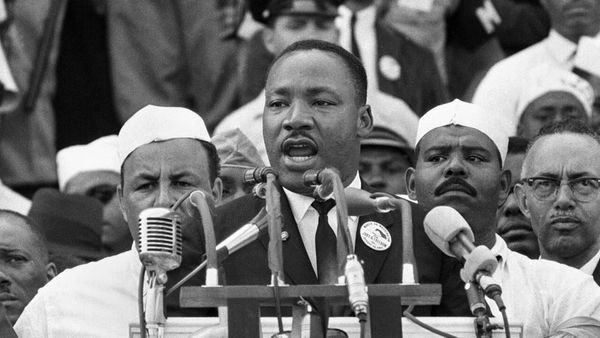Within the next fortnight, subject to a virtual “roll-call of Democratic Party delegates”, vice president Kamala Harris will be confirmed as the presumptive Democrat candidate for the US presidency and will engage in a full-on battle for the White House with the Republican candidate, Donald Trump.
Harris will be crashing through many glass ceilings if she makes it to 1600 Pennsylvania Avenue North West – or, as it is better known, the White House. She would be the first woman president, and also a woman of colour with both Indian and Jamaican heritage. But she would also be the first Democrat to win an election from a political powerbase in California.
In the exceptional republic that is the US of A, California is truly exceptional – and that grates with much of the rest of the country. It, and the people who hail from it, are too big, too rich, too inventive, too liberal – and altogether just too much, if you are from anywhere else, that is.
If California was a nation, it would have the world’s fifth largest economy. It contributes around 15% of US GDP, way out of proportion to other states, and is home to tech giants including Apple, Meta and Google, alongside major corporations such as Visa, Chevron and Wells Fargo.
And just down from Silicon Valley you’ll find the Hollywood Hills, home to the myth and mystery of the movie business. Hollywood has given us such California politicians as former governor Arnold Schwarzenegger, Clint Eastwood – mayor of Carmel-by-the-Sea – and a one Ronald Wilson Reagan, who made the political journey from Democrat to conservative Republican. But more on him later.
For the US heartland, California feels like a separate country. Somehow, being far west has turned it – and particularly its Democrat politicians – far left in the minds of those Midwesterners, and there is almost no history of significant runs for the presidency for politicians who’ve cut their teeth in its capital, Sacramento.
Barring Harris’ own halting run in 2020, you have to look back to 1992 for the last serious Californian tilt at the presidency. This was when the then governor, Jerry Brown, made his final run, offering a serious challenge to Bill Clinton before choosing Rev Jesse Jackson as his vice-presidential pick, something that a small-c conservative country was just not ready for. And before Brown? Pretty much zilch.
So where should Harris look to for inspiration and does the stereotype of California failures actually hold weight? She can look to Diane Feinstein and Barbara Boxer, who smashed the California glass ceiling when they were elected in 1992 as the state’s first women senators. The liberal Boxer was actually succeeded in the Senate by Kamala Harris, who then served alongside Feinstein in Congress.
Feinstein, who died last year, made her name as mayor of San Francisco and served in the Senate for more than 30 years. Her decline – and refusal to retire – has more than a few echoes, not with Harris, but with Joe Biden. And if Harris needs further inspiration of a successful woman in Washington, she need look no further than Nancy Pelosi as the first female speaker of the House and, until her retirement from the speakership, one of the key leaders in legislative government.
Across the aisle
The reality is, of course that California has produced a raft of successful politicians at the highest level – but to date, they have been men, and they have been Republican. Midwesterners don’t actually mind Californians – as long as they’re conservative Californians.
While John Fremont came close in 1856, just six years after California entered the Union, the first Republican president from the state was Herbert Hoover in 1928. He swept the country other than the Dixie South and New York, campaigning to maintain US prosperity.
The Wall Street crash and the Depression put paid to a Hoover second term and while the Republicans won the presidency back under Eisenhower in 1952, the most prominent Californian appointment of the 1950s was Earl Warren as chief justice of the US Supreme Court. He presided over a reforming Court, most especially around civil rights.
Next up to bat for the presidency was former vice-president Richard Nixon, who benefited from the chaos among the Democrats in 1968 following LBJ’s decision not to run, to beat the incumbent Democratic vice-president Hubert Humphrey – surely a lesson for Harris.
Finally, Kamala Harris could look to Reagan – former actor, former labour leader, former governor and a failed candidate in 1976 – for inspiration. In 1980 he won the presidency on the back of deep economic malaise, but by 1984 his mix of old-time folksiness mixed with steely determination made him unstoppable. For a generation it definitely was “Morning again in America”, as his campaign slogan ran.
If Harris can capture that same sense of hope, of empathy and of positivity, she may regain the ground lost by Joe Biden to his challenger. Perhaps she can break the Democrats’ Californian curse. And in the end, is California really too different? Is it any more “exceptional” than, for instance, New York – the birth place and long-time home to one Donald J Trump?
Mark Shanahan does not work for, consult, own shares in or receive funding from any company or organisation that would benefit from this article, and has disclosed no relevant affiliations beyond their academic appointment.
This article was originally published on The Conversation. Read the original article.







